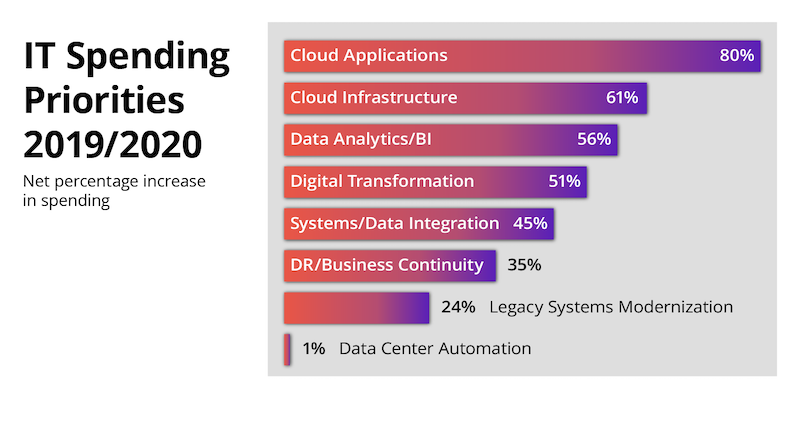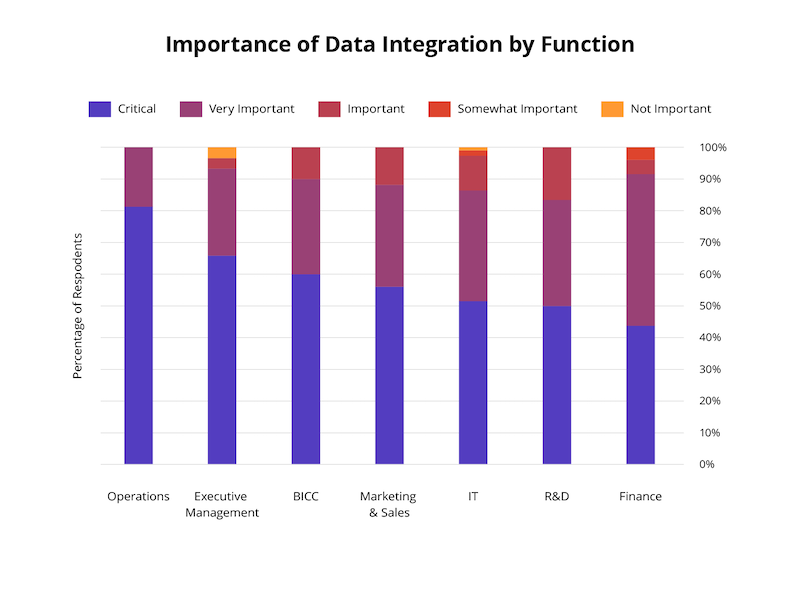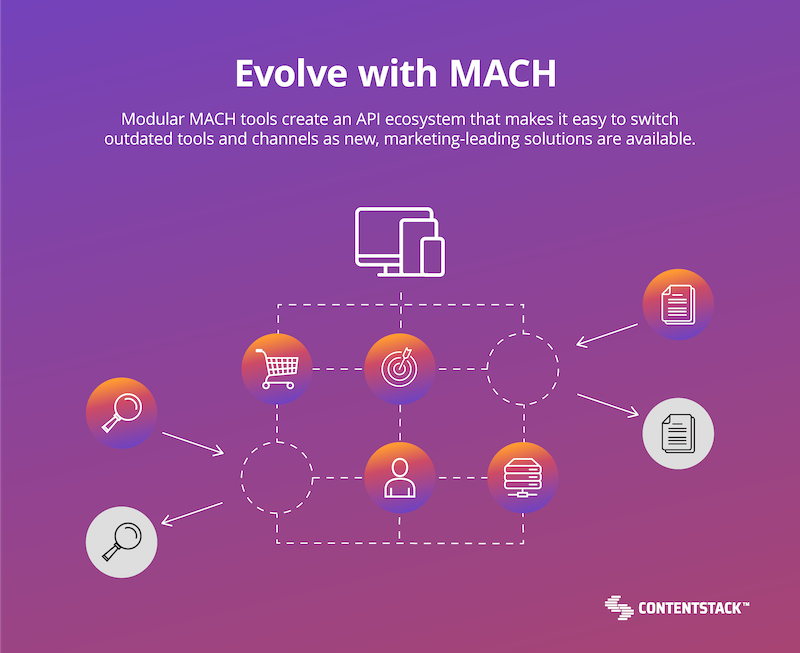
As digital business expands, so does the enterprise software market.
The good news is that modern software options can support any digital experience you dream up. The bad news is that finding these tools can be like finding a needle in a marketing buzzword haystack.
One term that is quickly becoming part of software design and marketing lingo is MACH (microservices, API-first, cloud-native, headless). MACH technologies are built from the ground up to be modular, pluggable, scalable, and to support a continuously evolving digital experience.
Enterprises are eager to adopt these new principles. 80% of 2020 IT budgets have cloud applications as a top priority while legacy system integration was only a priority in 24%.

Legacy vendors have noticed this trend, and many have tried to make “quick-fixes” when it comes to cloud and APIs, spinning their marketing message to match.
When everyone is using the same language, it can be hard to determine which technology is the real deal. Here are six ways to look behind the marketing curtain and select the best modern tools for your experience.
1. No “All-in-One” Messaging
Back when “digital business” meant merely having a website, it made sense for one platform to be able to support all of a company’s digital needs. As the scope of digital businesses expanded — from marketing to commerce to customer service and everything in between — so did the amount of functionality needed to manage it.
Some larger platforms that would like to keep their business model of being the one-stop-shop for digital, have tried to add on more functionality to keep up. They build their product with the intention that customers will exclusively use the functionality in the platform, and don’t make it very easy to substitute with other tools. This means that if you choose a platform for its best features, you also get locked into the not-so-great ones.
Digital Experience is too varied for any single vendor to master every part of it. As digital becomes a major way that businesses differentiate themselves, the chances of finding a single platform that aligns perfectly with every goal of an enterprise’s roadmap are slim.
MACH tools address this issue. Built to integrate at a functionality level, they aim to be a part of a “composable enterprise” where a business has the freedom to assemble a toolkit that fits their unique needs. They support modern approaches to complex projects, such as hyper-personalization, that require data orchestration across multiple tools and teams. MACH vendors focus on proving the best solution for their digital experience domain and integrating easily with everyone else.
What to look for:
- No “all-in-one” messaging that claims the platform can manage the entire digital experience.
- Documentation and guides on integrating with other tools, especially in the classes of technology most crucial to your ecosystem.
- The five factors listed below exist in technologies built to integrate from the ground up.
2. API-First, Not API-Added
Across functionalities, over 80% of enterprise employees say that data integration is “critical” or “very important” to business. Even if the “all-in-one” platforms want to be the single source of experience functionality, they know they aren’t the only source of data to power that experience. Every enterprise software on the market will provide some sort of API to share data.

However, there is a big difference between platforms that have added APIs to a monolithic codebase and ones that have been built with APIs from the ground up.
APIs are often compared to Lego bricks, in that their standardized nature lets you click different applications to each other. Some platforms were originally built as full, monolithic boxes before APIs became a standard design practice. They have added APIs by gluing Lego bricks to the outside of this box, and wiring up the inside of the box to push and pull specific data through this brick. For some tools, like ERP and CRM, this push and pull of data is all that is needed.
For customer experience tools, like content management and ecommerce, there needs to be more flexibility than a few specific Lego bricks can provide. MACH tools are built with APIs from the ground up, so that every functionality — across the management console, product UI, back-end, etc. — is accessible through an API. The entire solution is built with Lego bricks, and a business can organize these modular functionalities to fit unique plans, projects, and other digital experience tools.
What to look for:
- There is documentation available for multiple APIs.
- There are no software add-ons or plugins; functionality is extended exclusively through APIs.
- A product history that has always been API-first. No announcements of “introducing APIs.”
- If specifically a headless technology, there should be no presentation layer available. A presentation layer that has been decoupled is a sign that the product has added APIs.
3. Everything as a Service
The API-first design, combined with being cloud-native, allows MACH software to provide functionalities as a collection of microservices so each microservice can be individually tested, updated, deployed, and scaled.
This is why most MACH software is available as Software-as-a-Service (SaaS). In this subscription licensing model, the vendor centrally hosts the application and provides access via the cloud. Resources, and the cost of those resources, can be easily scaled up and down as needed.
Just as having an API doesn’t make you API-first, having a cloud offering doesn’t make you SaaS. As more businesses head towards cloud architecture, legacy software vendors are offering their software in the cloud as managed services. The vendor will take care of the hosting, but the software still requires custom installation and manual upgrades.
SaaS, on the other hand, requires no installation. Because individual microservices can be upgraded and delivered instantly, updates are continuously delivered. There is no version 1, version 2, version 3, etc. of the software that requires re-installation — the software is a continuously evolving application that is automatically up to date.
Some legacy vendors will say that managed services let you customize your platform, while SaaS is an off-the-shelf option. And, to be fair, the off-the-shelf standardization of the services is what allows SaaS products to upgrade automatically. However, customization shouldn’t be happening at a platform level anyways.
Let’s take it back to the Lego example. For a managed service offering, the vendor will customize that monolithic box to push and pull the data you want through the glued-on Lego brick. A company pays a flat price for the whole box, regardless of how much of it they use. When the vendor updates their box, they will help rewire this new version of the box to make sure it works like the old one. It is customized, yes, but it requires custom work for each new version.
The SaaS offering, on the other hand, is made up of Lego bricks that are standard for everyone. That standardization means that when a brick is updated, that update can be given to everyone, and that brick will be compatible in any previous scenario — no custom work required. Updates can be scaled, so customers get more of them. Companies are then free to assemble those bricks to meet custom goals and only pay for the bricks they use.
What to look for:
- No software download required.
- A subscription model of payment based on resources or users. No licensing model based on versioning.
- Upgrades are rolling and automatic, there is no service cost or time estimated for version upgrades.
4. Supports Modular Implementation
Due to all the above factors, MACH technologies offer businesses significant benefits. They let companies escape the re-platform cycle thanks to modular implementation.
Legacy tools usually require a “big bang” launch. Going live with a new software means completing ripping out and untangling the dependencies of your old solution, re-mapping those to the new one, and ensuring the entire setup is perfectly in place before launching — or risk a cascade of errors.
With MACH tools, the process is less “ripping” and more “clicking.” This is due to a few different reasons.
First, because they aren’t meant to be “all-in-one” platforms, MACH tools make it easy to integrate with the investments you already have — including the platform they are set to replace. Teams can have access to new functionalities right away, while gradually weaning off of the legacy platform.
Second, their decoupled services can be tested, updated, and deployed independently. Multiple teams can work in parallel, and changes can be made without the risk of cascading errors.
Third, because of their independent nature, projects can go live one at a time. You can get a fully functioning project up and running in a few weeks, such as a new checkout or customer support process, and evolve your experience step by step.

MACH tools are designed to evolve. To learn more, and for real examples of companies making the switch to MACH, check out the recently published ebook: Break the Replatform Cycle with MACH Enterprise Architecture.
What to look for:
- It should be possible to use any functionality of the product on its own, without requiring the full kit and kaboodle to get started.
- Headless software. While not all MACH solutions are headless, it is a good indicator that the software has independent services.
- Reference customers who have had success with modular implementation.
5. Offers A Proof of Concept
Always try before you buy. If a vendor claims their software provides agility and speed, but they are hesitant to demonstrate that with a proof of concept — that’s a red flag.
Hacking your way past a vendor’s sales deck is the best way to see behind the marketing curtain. Choosing a real business case for this project lets you ensure that the solution fits into your ecosystem, and proves that the software holds up beyond the polished demo.
It also gives you a chance to see if the vendor is the right match to partner with. MACH tools are a new venture for many companies, and it’s essential to have a vendor that you feel you can rely on to help you figure it out.
What to look for:
- The APIs, documentation, and SDKs are easy to work with.
- The UI is easy for all relevant teams to adopt.
- The vendor’s customer service is helpful throughout the process.
Emphasis on Partnership
Digital is the new competitive battleground, which means companies need unique experiences that set them apart. This means that businesses need to choose a network of software providers that are willing to work with them on initiatives that haven’t been done before.
Along with the support for new experiences, the SaaS model requires businesses to trust vendors to be transparent about day-to-day performance. With SaaS, enterprises are relying on vendors to be up to date with security, stability, and performance — and upfront about any issues that arise.
On top of that, because there is no “all-in-one” platform market anymore, these vendors not only need to work well with you but with each other. Larger digital projects will require effort from multiple providers, and poor communication between parties can slow down efforts. When running the proof of concept, a kick-off meeting that includes your current key vendors can help determine if everyone is a good fit.
What to look for:
- Customer reviews on sites like G2, Capterra, Gartner, and Forrester.
- Recommendations from current vendors that you trust.
- Ask what recent feature has been added based on a customer suggestion, if they partner with customers on new initiatives they should have an answer.
For a deeper look at the benefits of MACH tools and how real companies are making the switch to a MACH architecture, check out our ebook: Break the Replatform Cycle with MACH Enterprise Architecture.
Ready to evaluate a vendor? Try these 30 RFP questions to ask your headless CMS candidates.




